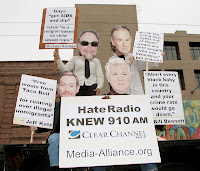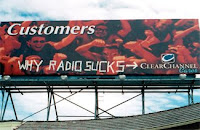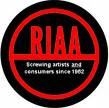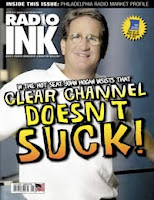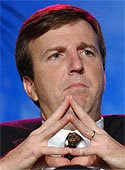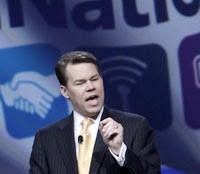
Peter Smyth is the Chairman and CEO of the Boston-based Greater Media.
I’ve never met him. What I know of him comes from reading his radio-as-a-victim blogs.
I’m familiar with his stations. He has two of the best rock radio PDs in the business on his payroll.
I hear he allows managers make their own decisions and, for that reason, has a low turnover. Some say he's loyal to a fault.
I’ve read his bio. Spending most, if not all of his adult life in Boston and being in the radio business he has to know first hand that in the past half century the market has produced some of the best talk radio hosts in America: Jerry Williams, Larry Glick, Paul Benzaquin, Ken Mayer, Bob Kennedy, Peter Meade, Paul Sullivan, and David Brudnoy.
Just short of a year ago, Peter Smyth asked an open question in his monthly blog: “How in the world did we become the bad guys?”
It was in reference to the imminent Sirius-XM satellite radio merger.
He defended terrestrial radio by claiming, “Local, free radio represents every demographic and every community in the nation. We employ hundreds of thousands of dedicated and talented individuals, from every city and town in America. We deliver local news, weather, traffic, and sports updates every hour, every day, 365 days a year. We raise hundreds of millions of dollars every year for local and national charities and people in need.”
Exaggerated? Certainly. We know of many markets that don’t have a single radio station that provides those services and we can count on one hand the number of stations that do so every hour, every day, 365 days a year.
But let’s get back to that “bad guy” question. Specifically, what makes you a bad guy, Peter?
Is it your forgiveness of hate on the public airwaves?
 Is it your support of a vile bombastic xenophobe named Jay Severin who does afternoon drive on your WTKK-FM in Boston?
Is it your support of a vile bombastic xenophobe named Jay Severin who does afternoon drive on your WTKK-FM in Boston?This clown makes Michael Savage sound moderate by comparison.
Like you, I support the First Amendment, which safeguards speech from state restraint.
I won’t dispute the fact that you have the right to fill every one of your radio stations with vicious, bigoted commentary if you so desire.
And you do have the autonomy to pay Jay Severin a million dollars-plus a year to call Mexicans “criminaliens,” “leeches,” and disease spreaders.
Once, when a caller defended Muslims, Severin replied, “I have an alternative viewpoint. It's slightly different than yours. You think we should befriend them; I think we should kill them.”
And what exactly does he mean when he says President Barack Obama must be “stopped at all costs?”
 You, as the CEO of a privately-held company, also have to right to terminate an employee for “just cause.” I’m pretty certain Greater Media, as a private sector employer, established specific guidelines to follow when disciplining or terminating employees.
You, as the CEO of a privately-held company, also have to right to terminate an employee for “just cause.” I’m pretty certain Greater Media, as a private sector employer, established specific guidelines to follow when disciplining or terminating employees.I have to ask. What exactly was it that he said that made you to pull him off the air for a month?
Before I go any further, let me make it clear that this is no liberal versus conservative rant.
My concern is that when a talk show host uses words like “kill” and “stop at all costs” responsibility becomes compromised.
I'll credit you for shrewdly manipulating the media just enough to keep Severin's name in the news nearly every day in May.
Since it’s apparent that Severin has enough clients willing to market to his bottom-feeding hate mongering audience you now feel he’s worthy of keeping on the public airwaves and deserves every penny of the million a year plus bonuses you’re paying him to spew his racial rhetoric.
Just because it’s not illegal makes it right.
 So what if Jay Severin, the dogmatist formerly known as James Severino, has a checkered past?
So what if Jay Severin, the dogmatist formerly known as James Severino, has a checkered past?He didn’t really lie about having a master’s degree in journalism from Boston University. He just forgot he didn’t have one.
When he claimed he won a Pulitzer Prize? Come on, we know he was only kidding.
Severin also claims to be a former Republican Party political consultant, who “worked” on the presidential campaigns of George H. W. Bush in 1980 and Pat Buchanan in 1996. Exactly what he “worked” on remains ambiguous.
One fact Severin declined to reveal is that among 25-54 year olds, his show is Arbitron People Meter rated 15th place. That’s pretty bad for a station whose slogan should be “Race bait and ye shall receive.” His conservative talk archnemesis Howie Carr on Entercom’s WRKO is in fifth.
 On Saturday, the WTTK website announced that “On Tuesday June 2nd, at 3 p.m., Jay Severin will return to the weekday afternoon timeslot on Boston's Talk Evolution 96.9 FM-WTTK. Jay regrets the remarks for which he was suspended and understands that his comments were indeed wrong and hurtful to the Mexican and Mexican-American communities. Accordingly, we feel it is time to end Jay's suspension and welcome him back to WTKK. All of our hosts have strong opinions and talk radio is a format for open and spirited debate about the many issues we face in Boston, New England, our nation and our world. There will no doubt be times when you disagree with Jay - and our other hosts too - but our ultimate goal is to maintain a level of conversation that is entertaining, compelling, and thought-provoking, yet civil and respectful. While we will not always succeed in walking this line, we will continually strive to do so.”
On Saturday, the WTTK website announced that “On Tuesday June 2nd, at 3 p.m., Jay Severin will return to the weekday afternoon timeslot on Boston's Talk Evolution 96.9 FM-WTTK. Jay regrets the remarks for which he was suspended and understands that his comments were indeed wrong and hurtful to the Mexican and Mexican-American communities. Accordingly, we feel it is time to end Jay's suspension and welcome him back to WTKK. All of our hosts have strong opinions and talk radio is a format for open and spirited debate about the many issues we face in Boston, New England, our nation and our world. There will no doubt be times when you disagree with Jay - and our other hosts too - but our ultimate goal is to maintain a level of conversation that is entertaining, compelling, and thought-provoking, yet civil and respectful. While we will not always succeed in walking this line, we will continually strive to do so.” “There’s 10 years of context here of me . . . and because of my extraordinarily strong relationship with my colleagues and with (Greater Media chairman and CEO) Peter Smyth, I was confident - with a commitment to do the kind of show that they want me to do and I think the audience wants me to do - that this would be worked out,” Severin told the conservative Boston Herald yesterday.
“There’s 10 years of context here of me . . . and because of my extraordinarily strong relationship with my colleagues and with (Greater Media chairman and CEO) Peter Smyth, I was confident - with a commitment to do the kind of show that they want me to do and I think the audience wants me to do - that this would be worked out,” Severin told the conservative Boston Herald yesterday.And that’s "how in the world" some people become bad guys.




